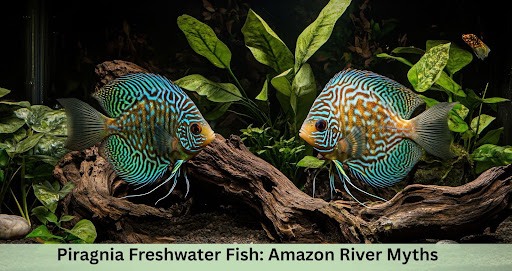Introduction to Piragnia Freshwater Fish Amazon
Deep within the lush greenery of the Amazon River, a fascinating creature lurks—the piragnia. Often misidentified as just another terrifying piranha, this freshwater fish is steeped in myths and legends that amplify its fearsome reputation. The piragnia’s sharp teeth and predatory nature have captured imaginations around the globe, fostering an aura of intrigue and apprehension.
Despite their fierce appearance, there’s much more to these fish than meets the eye. Understanding their true nature requires peeling back layers of cultural myths and misconceptions surrounding them. As we embark on a journey through the waters of the Amazon River, we’ll uncover where these captivating creatures originate from, what makes them unique, and how they fit into their complex ecosystem.
Join us as we dive deep into the world of piragnia—where science meets myth—and explore what truly defines this enigmatic species in one of Earth’s most biodiverse habitats.
Origins and Habitat of Piragnia in the Amazon River
The piragnia, often confused with the infamous piranha, has its roots deeply embedded in the rich tapestry of the Amazon River. This fascinating fish thrives in one of the most biodiverse ecosystems on Earth. The vast river system spans several countries, including Brazil, Peru, and Colombia.
Piragnia are primarily found in freshwater environments such as rivers, lakes, and floodplain areas. They prefer slow-moving waters with plenty of vegetation that provides shelter and breeding grounds. These habitats play a crucial role in their survival by offering abundant food sources and protection from predators.
In terms of geographical distribution within the Amazon basin, piragnia can be spotted from the main river channels to smaller tributaries. Their presence indicates a healthy ecosystem since these fish rely on a balanced aquatic environment for feeding and reproduction.
Interestingly, seasonal changes also affect their habitat preferences. During wet seasons when water levels rise significantly, piragnia often move into flooded forests where they can access more resources.
Understanding where piragnia thrive helps researchers monitor environmental health in this unique region. Conservation efforts hinge on protecting both their habitats and broader ecological systems vital for sustaining life along the Amazon River.
Key Characteristics of Piragnia Freshwater Fish
Piragnia freshwater fish, often confused with their notorious cousins, the piranha, exhibit distinctive features that set them apart. These fascinating creatures belong to the Serrasalmidae family and thrive in South American waterways.
One of the most notable characteristics of piragnia is their size. Typically ranging from 8 to 16 inches in length, some species can grow even larger under optimal conditions. Their streamlined bodies enable swift movements through river currents.
The coloration of piragnia varies depending on the specific species and environmental factors. Many are adorned with striking patterns of silver or gray scales that help them blend into their surroundings while hunting for food or evading predators.
Teeth structure is another defining feature. Unlike piranhas known for their razor-sharp fangs, piragnia have a more varied dental arrangement suited to their omnivorous diet that includes plant matter as well as smaller aquatic animals.
These fish possess a unique adaptation: a specialized swim bladder allowing them to control buoyancy effectively. This ability aids in navigating both shallow waters and deeper sections of the Amazon River ecosystem effortlessly.
Piragnia vs. Piranha: Separating Fact from Myth
Piragnia and piranha are often confused, but understanding their differences is crucial. Both belong to the same family, Serrasalmidae, yet they have distinct characteristics that set them apart.
The term “piranha” typically refers to a few specific species known for their sharp teeth and aggressive behavior. On the other hand, “piragnia” encompasses a broader category of freshwater fish found in the Amazon River system. While all piragnia can be classified as members of this group, not every piranhа falls under it.
A common myth surrounding these fish is that they are relentless predators eager to attack anything that enters their territory. In reality, many species within both categories are more scavengers than hunters. They play vital roles in maintaining ecological balance rather than posing constant threats.
Another misconception involves size; people often believe all piranhas grow large enough to inflict serious harm on humans or animals. However, most species remain small and pose little risk beyond typical fishing encounters.
Understanding these distinctions helps demystify the reputation of piragnia within popular culture while highlighting their importance in biodiversity and ecosystem health in the Amazon River basin.
Common Misconceptions About Piragnia Freshwater Fish
Many people associate piragnia with ferocious behavior due to their portrayal in films and television. However, this is far from the truth. While they can exhibit aggressive tendencies, particularly when provoked or during breeding seasons, they are not mindless killers.
Another common misconception is that all species of piragnia have razor-sharp teeth capable of inflicting serious harm. Though their teeth are indeed sharp and suited for tearing flesh, most species primarily feed on smaller fish and plant material. Their diet does not always consist of larger prey as many believe.
Some also think that piragnia travel in large schools solely for hunting purposes. In reality, they often form groups for social interaction or safety rather than coordinated attacks against larger animals. This misunderstanding contributes greatly to their fearsome reputation.
Additionally, there’s a belief that these fish will aggressively attack humans without provocation. While there are rare instances where bites occur—typically related to fishing practices—piragnia generally avoid human contact unless threatened.
It’s important to highlight the misconception surrounding their habitat preferences. Many assume they only thrive in murky waters; however, piragnia can adapt to various freshwater environments throughout the Amazon basin while still maintaining healthy populations.
Role of Piragnia in Amazon River Ecosystem
Piragnia play a crucial role in the Amazon River ecosystem. As apex predators, they help maintain the balance of aquatic life. Their feeding habits influence the populations of smaller fish and invertebrates, ensuring no single species dominates the habitat.
These fish are opportunistic feeders, consuming a variety of prey. This diet includes insects, crustaceans, and even other fish. By controlling these populations, piragnia contribute to the overall health of their environment.
Moreover, their presence indicates a well-functioning ecosystem. Healthy piragnia populations suggest that water quality is good and food sources are abundant. They serve as indicators for scientists monitoring environmental changes within the Amazon.
The reproduction cycle of piragnia also affects biodiversity. During breeding season, they engage in fascinating mating behaviors that attract not only mates but also researchers keen on understanding their biology better.
Other wildlife relies on piragnia as part of their diet. Birds and larger mammals may hunt them for food when venturing near riverbanks or shallow waters. This interconnected web highlights how vital each species is to sustaining life along this magnificent river system.
Cultural Myths Surrounding Piragnia Freshwater Fish
Cultural myths surrounding piragnia freshwater fish are as diverse as the communities that inhabit the Amazon Basin.
Indigenous tribes often tell tales of these fierce fish, attributing supernatural qualities to them. Some believe that a single bite can lead to instant death, highlighting their feared reputation.
In many local cultures, piragnia symbolize bravery and resilience. Fishermen might wear talismans or charms featuring these fish for protection while navigating the treacherous waters of the Amazon River.
This reverence underscores how integral piragnia are to community identity and spiritual beliefs.
Movies and media have further amplified misconceptions about these creatures. The portrayal of piragnia as bloodthirsty predators feeds into an exaggerated image that fuels fear among those unfamiliar with them. Such dramatizations overlook their role in maintaining ecological balance within their habitat.
Stories of pirate legends also intertwine with cultural narratives involving piragnia, painting them as accomplices in tales of hidden treasure and lost souls in river currents. These narratives enhance the mystique surrounding this species but often lack scientific basis.
As a result, understanding local lore is essential for grasping how people perceive these remarkable fish. It highlights both respect and fear—a complex relationship shaped by centuries of observation and storytelling.
Are Piragnia Dangerous to Humans? What Science Says
Piragnia, often mistakenly referred to as piranhas, have gained a notorious reputation for being dangerous. However, scientific research presents a more nuanced view of these fish.
While they are carnivorous and equipped with sharp teeth, their interaction with humans is generally limited.
Most species of piragnia do not pose a significant threat to people under normal circumstances. They tend to avoid human contact and prefer the company of other fish in their native habitats.
Attacks on humans are rare and usually occur only when the fish feel threatened or provoked.
The real danger arises during specific conditions such as low water levels or food scarcity, which may lead them to exhibit aggressive behavior.
In these situations, they might defend their territory more fiercely than usual. Nonetheless, most encounters can be avoided through respect for their environment.
Studies indicate that piragnia have social structures within schools which help them hunt effectively while reducing individual risks from predators — including larger animals like caimans or birds.
Education plays a crucial role in dispelling fears about piragnia. Understanding their behavior helps in appreciating these fascinating creatures without unwarranted fear of aggression towards humans.
Conservation Status of Piragnia in the Amazon
The conservation status of piragnia in the Amazon River is a matter of growing concern among ecologists and environmentalists. These fascinating fish play an essential role in their aquatic ecosystem, yet numerous threats jeopardize their survival.
Habitat destruction remains one of the most significant challenges facing piragnia species. Deforestation for agricultural expansion and urbanization leads to degraded water quality and altered river systems. This not only impacts the availability of food sources but also disrupts breeding grounds.
Overfishing poses another serious risk. Local communities often catch piragnia for food or fishing tourism, leading to declining population numbers if sustainable practices are not adopted. The demand for these fish can easily outstrip natural recovery rates if proper management strategies aren’t implemented.
Moreover, climate change adds further pressure on their habitats, affecting water temperatures and flow patterns within the Amazon River basin. Such changes may alter migration routes and spawning seasons critical for reproduction.
Conservation efforts must focus on habitat restoration, sustainable fishing practices, and increased public awareness about this unique species’ ecological importance.
Educating local communities can empower them to take part in preserving both their cultural heritage linked with piragnia as well as ensuring its continued existence in the wild.
Final Thoughts on Piragnia Freshwater Fish Amazon
Piragnia freshwater fish, often mistakenly called piranhas, play a significant role in the Amazon River ecosystem.
Their unique adaptations and behaviors contribute to the rich biodiversity of this vital habitat. While many myths surround these fascinating creatures, understanding their true nature is essential for appreciating their place within the aquatic community.
From their diverse feeding habits to their interactions with other species, piragnia are more than just ferocious predators. They help maintain ecological balance by controlling prey populations and contributing to nutrient cycling in river systems. The cultural stories that depict them as ruthless killers stem from fear rather than fact.
As we navigate through ongoing environmental changes and threats to the Amazon rainforest, it’s crucial to consider conservation efforts for piragnia and other aquatic life forms. Protecting these species helps ensure healthy ecosystems that can thrive for generations.
The next time you think about piragnia freshwater fish or hear tales surrounding them, remember there’s much more beneath the surface than mere myth.
Embracing accurate knowledge fosters respect for these remarkable fish while promoting awareness of their importance in our world’s most extraordinary rivers.




